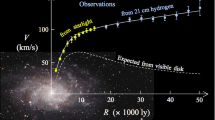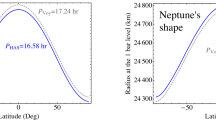Abstract
It is known that slow baryon outflow influences the evolution of dwarf spheroidals (dSphs) around the Milky Way. However, one may ask: what dSphs are too small? Actually, the depth of the gravitational potential of very small dSphs discovered recently is estimated as the energy of only one supernova explosion. This means that the loss of interstellar medium should be fast. Then, adopting a dSph formation scenario, which considers the fast baryon loss, we investigate which mass loss is important. According to our estimates, when only baryon mass loss is considered, the observational radius is larger than that expected in that scenario for all of the very small dSphs. This indicates that the expansion of the system is caused by slow dark matter outflow.
Similar content being viewed by others
References
Arimoto, N., Yoshii, Y.: Astron. Astrophys. 173, 23 (1987)
Belokurov, V., et al.: Astrophys. J. 654, 897 (2007)
D’Onghia, E., Besla, G., Cox, T.J., Hernquist, L.: Nature 460, 605 (2009)
de Rijcke, S., Michielsen, D., Dejonghe, H., Zeilinger, W.W., Hau, G.K.T.: Astron. Astrophys. 438, 491 (2005)
Dekel, A., Silk, J.: Astrophys. J. 303, 39 (1986)
Ferrara, A.: Astron. Soc. Pac. Conf. 285, 367 (2002)
Gilmore, G., Wilkinson, M.I., Wyse, R.F.G., Kleyna, J.T., Koch, A., Evans, N.W., Grebel, E.K.: Astrophys. J. 663, 948 (2007)
Hills, J.G.: Astrophys. J. 235, 986 (1980)
Irwin, M., Hatzidimitriou, D.: Mon. Not. R. Astron. Soc. 277, 1354 (1995)
Kamaya, H.: Astrophys. Space Sci. 317, 235 (2008)
Koposov, S.E., Yoo, J., Rix, H.-W., Weinberg, D.H., Macciò, A.V., Miralda-Escudé, J.: Astrophys. J. 696, 2179 (2009)
Kroupa, P.: New Astron. 2, 139 (1997)
Martin, N.F., de Jong, J.T.A., Rix, H.-W.: Astrophys. J. 684, 1075 (2008)
Mayer, L., Mastropietro, C., Wadsley, J., Stadel, J., Moore, B.: Mon. Not. R. Astron. Soc. 369, 1021 (2006)
Moore, B., Katz, N., Lake, G., Dressler, A., Oemler, A.: Nature 379, 613 (1996)
Peñarrubia, J., Navarro, J.F., McConnachie, A.W.: Astrophys. J. 673, 226 (2008)
Read, J.I., Pontzen, A.P., Viel, M.: Mon. Not. R. Astron. Soc. 371, 885 (2006)
Saito, M.: Publ. Astron. Soc. Jpn. 31, 181 (1979a)
Saito, M.: Publ. Astron. Soc. Jpn. 31, 193 (1979b)
Sakamoto, T., Hasegawa, T.: Astrophys. J. 653, L29 (2006)
Simon, J.D., Geha, M.: Astrophys. J. 670, 313 (2007)
van Dokkum, P.G., Kriek, M., Franx, M.: Nature 460, 717 (2009)
Weinberg, D.H., Colombi, S., Davé, R., Katz, N.: Astrophys. J. 678, 6 (2008)
White, S.D.M., Rees, M.J.: Mon. Not. R. Astron. Soc. 183, 341 (1978)
Yoshii, Y., Arimoto, N.: Astron. Astrophys. 188, 13 (1987)
Zucker, D.B., et al.: Astrophys. J., Lett. 643, L103 (2006)
Author information
Authors and Affiliations
Corresponding author
Rights and permissions
About this article
Cite this article
Kamaya, H. Comments on the final evolutionary phase of very small dwarf spheroidal galaxies. Astrophys Space Sci 327, 29–33 (2010). https://doi.org/10.1007/s10509-010-0308-z
Received:
Accepted:
Published:
Issue Date:
DOI: https://doi.org/10.1007/s10509-010-0308-z




